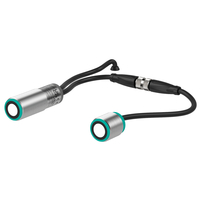Material Layer Detection in Battery Production
Double Sheet Sensor Prevents Infeed of Double Electrode Sheets

The Application
The electrodes of pouch cell Li-ion batteries consist of lots of extremely thin electrode sheets. When the battery elements are joined together, an anode sheet must always be followed by a cathode sheet, separated by an insulating layer. The cut sheets are taken from the cathode or anode stacks by vacuum grippers during the production process. After they are taken from the stacks, the electrode sheets are first aligned in the machine on an alignment table. Next, the sheets are picked up by another vacuum gripper and stacked alternately on top of each other on the battery stack. It is crucial for the quality of the battery cells that the gripper only pick up one sheet at a time so that the cathodes and anodes are always stacked alternately.
The Goal
The electrode sheets are extremely thin. Two or more sheets may stick together. An automatic layer check at the alignment table must reliably detect whether one or several sheets are on the table. If there is more than one layer, or if the gripper has not deposited a sheet at all, the stacking process must be interrupted and corrected. In this quick-moving process, sheets must be detected swiftly and reliably. The detection sensors must be easy to integrate into the machine. The functionality of these sensors must not be impaired by vibrations or other mechanical effects of the machine.
The Solution

Ultrasonic Double Sheet Sensors
An M18 series double sheet sensor reliably detects whether there are no electrode sheets, one electrode sheet, or several electrode sheets on the alignment table. The sensor does this without contact, so that the sensitive sheets are not damaged. Due to the robust ultrasonic principle of measurement, neither the color of the sheets nor their reflection behavior influence the detection quality. The parameters of the measuring process can be precisely adapted to the thickness of the wafer-thin sheets using a simple teach-in function. The device can easily be integrated into the plant control system via IO-Link.
Technical Features
- Noncontact ultrasonic double sheet detection
- Emitter/receiver distance: 20 mm to 60 mm
- Short reaction time of down to 1.5 ms possible
- Interface: IO-Link 1.1 (spec. 1.1.3)
- Degree of protection: IP65
- Temperature range: 0 °C ... 60 °C

The Benefits
The double sheet sensor is both extremely reliable and robust. The IO-Link interface enables access to all sensor parameters together with all diagnostic and process data. The interface allows for the detailed analysis of amplitude values and very simple commissioning and parameterization of the sensors. The immediate detection of an incorrect feed-in reliably ensures the quality of the finished battery cells.
At a Glance
- Robust principle of measurement ensures that layers of thin electrode sheets are detected
- Infeed of two sheets of material is reliably prevented
- Simple teach-in of the material parameters
- Comprehensive data flow and easy integration with IO-Link










 +91 80 4609 6000
+91 80 4609 6000